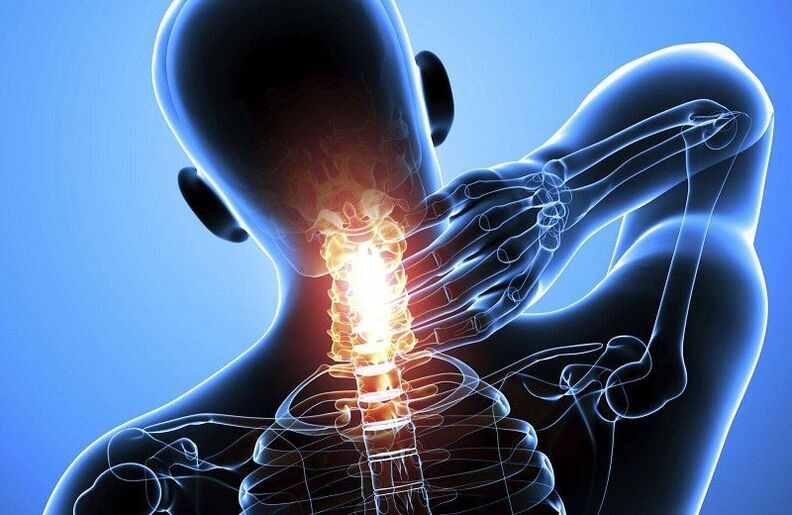Symptoms of cervical osteochondrosis are the manifestations of degenerative changes in the cartilage and discs. The development of pathology contributes to the subsidence and deformation of the vertebrae. As a result, patients experience pain, dizziness, and nausea.

first sign
The neck region contains the main blood vessels that supply blood to the brain. Micropulses from major organs and the central nervous system travel through nerve fibers. The severity of symptoms depends on the extent of the disease and individual characteristics. In cervical osteochondrosis, the intervertebral discs that perform depreciable functions are negatively affected by:
- The structure is changing.
- Due to the growth of bone tissue in osteochondrosis, the growths form in clusters. As a result, the blood supply deteriorates and nerve fibers fail.
The first symptoms of the disease do not manifest.
With the development of osteochondrosis in the neck, severe pain is observed - the main symptom. During exercise, discomfort intensifies and muscle tension develops.
There are different categories of people at risk. The process is determined by factors that contribute to the development of cervical osteochondrosis:
- a sedentary lifestyle;
- excess weight;
- Comorbidities - scoliosis, rheumatism;
- excessive physical activity;
- Spinal cord injury.
Symptoms of the next stage of osteochondrosis of the neck
Changes in cartilage tissue appear as signs, the severity of which depends on the severity of the dystrophic disease. The process can cause malfunction of any of the body's internal systems:
- Compression of nerve endings is characterized by symptoms in the form of osteochondrosis neuralgia. Neurological disorders can occur if the spinal cord is pinched. Bone growths that form on the nerve roots partially or completely fix the vertebrae, causing them to fuse. Sensitivity drops.
- Compression of primary and peripheral vessels is responsible for the lack of adequate blood circulation. Hypoxia occurs, and the work of the heart deteriorates. Symptoms of cervical osteochondrosis: frequent migraines, increased blood pressure, impaired coordination, vegetative vascular dystonia, impaired respiratory function. Hearing and vision problems may occur.

External
External symptoms are characterized by extensive damage to the body. In the first stage of pathology, patients do not complain of worsening general health. To prevent the onset of the disease, it is recommended to adopt an active lifestyle, go swimming and do healthy exercise.
The sensation of stage II cervical osteochondrosis is characterized by pain, resulting in stiffness of movement.
Discomfort can be located in different areas of the spine. Decreased patient performance. Squeezing the arteries can lead to general weakness, migraines. Tilt and turn the head can increase the discomfort of osteochondrosis.
The third stage of the disease is determined by more pronounced symptoms: on palpation of the pathological area, severe pain, immobility, movement characterized by tightening, dizziness, nausea. This condition manifests as loss of consciousness and the patient feels a lump in the throat. Violation of blood circulation can lead to increased blood pressure and high blood pressure. Numbness in upper limbs.
Stage four is determined by disease progression. With advanced forms of cervical osteochondrosis, patients may become disabled. The main symptom is cervical spine immobilization. Compression of arteries and nerve fibers is greatest and manifests as tinnitus, visual disturbances, and hearing. There is a violation of language - numbness of the tongue, loss of coordination.
Osteochondrosis located in the neck is treated with conservative medical therapy.
Doctors prescribe physical therapy, gymnastics to improve health. To eliminate pain syndromes during pathological exacerbations, general intensive massage is recommended.
Internal
Internal symptoms characterize changes in cartilage tissue structure in osteochondrosis:
- Manifestations of stage I osteomalacia. The physiology of the ridge is disturbed. Due to the lack of fluid, the discs between the vertebrae are narrowed in position. Muscle hypertonicity occurs.
- Stage II of cervical osteochondrosis is determined by thinning of the intervertebral discs and their reduced height, which increases the load on the musculoskeletal system. The result is pain.
- The third phase. Deformation of cartilage, growth of bone tissue, the formation of intervertebral herniation, herniation occurs. The case of disk falling out is fixed. The symptoms of the condition are characterized by severity. Arthropathy begins to progress.
- Phase IV. Completely destroys the disc between the vertebrae and further replaces the space with bone or connective tissue. This process results in the formation of products.
To prevent the development of the disease, it is recommended to perform regular exercises at home aimed at strengthening the muscles of osteochondrosis. To relieve pain, special medicines, ointments, injections are prescribed. Folk remedies are applied in the form of compresses, bandages.

Do symptoms differ in men and women?
The neck is the most flexible part of the musculoskeletal system, and it has 7 vertebrae. The sector starts at the chest and connects to the skull. Signs of cervical osteochondrosis in women are indistinguishable from pathological findings in men. According to statistics, women are more prone to this disease, which is due to the anatomical structure and the possibility of pregnancy.
The course of the disease depends on accompanying conditions, hormonal levels, symptoms, and other factors.
| difference | men | female |
|---|---|---|
| spine cross section | larger size. | smaller. |
| performance of system functions | The body is always under stress. Fractures are less frequent due to the muscular development. | It adapts better to the load. Osteochondrosis, a curvature in the form of scoliosis, osteoporosis is often diagnosed. |
| clinical picture | A country is characterized by stability. Lower pain threshold. The patient was unable to clearly describe all the signs. | Symptoms are obvious. The patient made a clear complaint. |
| age change | The agency is immune to internal system restructuring for 45-50 years. | Changes observed after pregnancy, hormonal changes after age 45. Pain and hand numbness may occur. |
The bearing of the fetus may be accompanied by the appearance of the following symptoms:
- The progression of cervical and lumbar osteochondrosis;
- squeeze nerve endings;
- Problems with the cardiovascular system;
- Movement is stiff.
Pathological diagnosis features
Comprehensive diagnosis of osteochondrosis in the neck, taking into account the degree and symptoms of the disease, is the key to improving the condition. To establish an accurate diagnosis, different methods are used:
- Inspection of. After contacting the doctor, use the parameters - gait, posture for visual assessment. Collect a complete patient symptom history.
- Radiography is considered an accessible examination method. It is characterized by possible consequences that affect the patient's general health. An X-ray of the neck area from the base of the skull to the upper chest. The study shows the state of the intervertebral discs.
- tomography. There are two types: computer and magnetic resonance (MRI). In the first case, with the help of special equipment, specialists take photo slices under the influence of X-rays. The resulting image is displayed on a computer screen and the 3D model is executed. The second type of inspection is based on electromagnetic wave work. Take layered photos of a body part.
If symptoms of osteochondrosis occurring in the neck are characterized by intensive development, a doctor should be consulted. To prevent this disease, an active lifestyle with regular exercise and swimming is recommended. In an advanced form of pathology, a course of treatment is prescribed, including the administration of pain relievers and normalizing the work of the internal systems of the body.



















